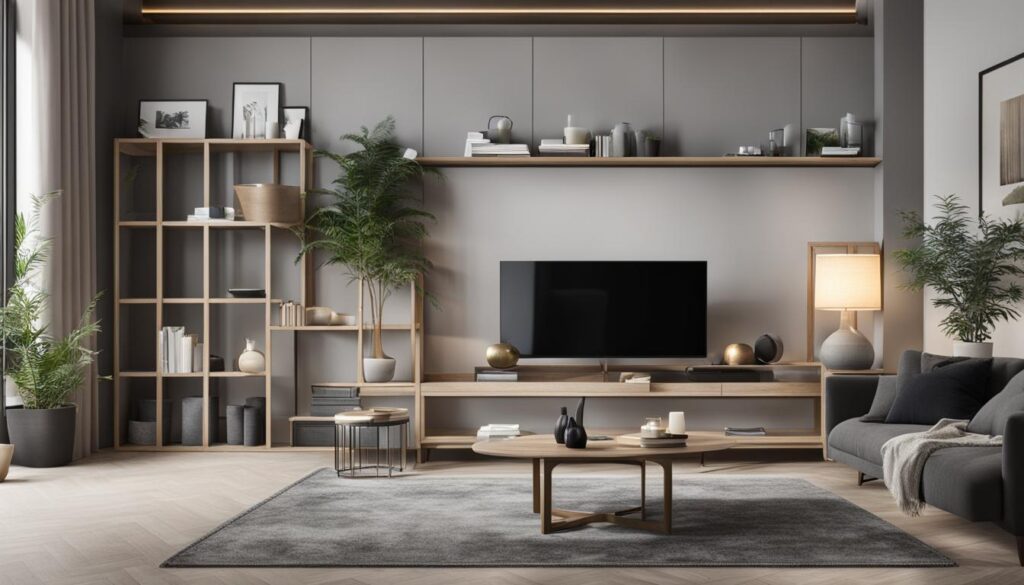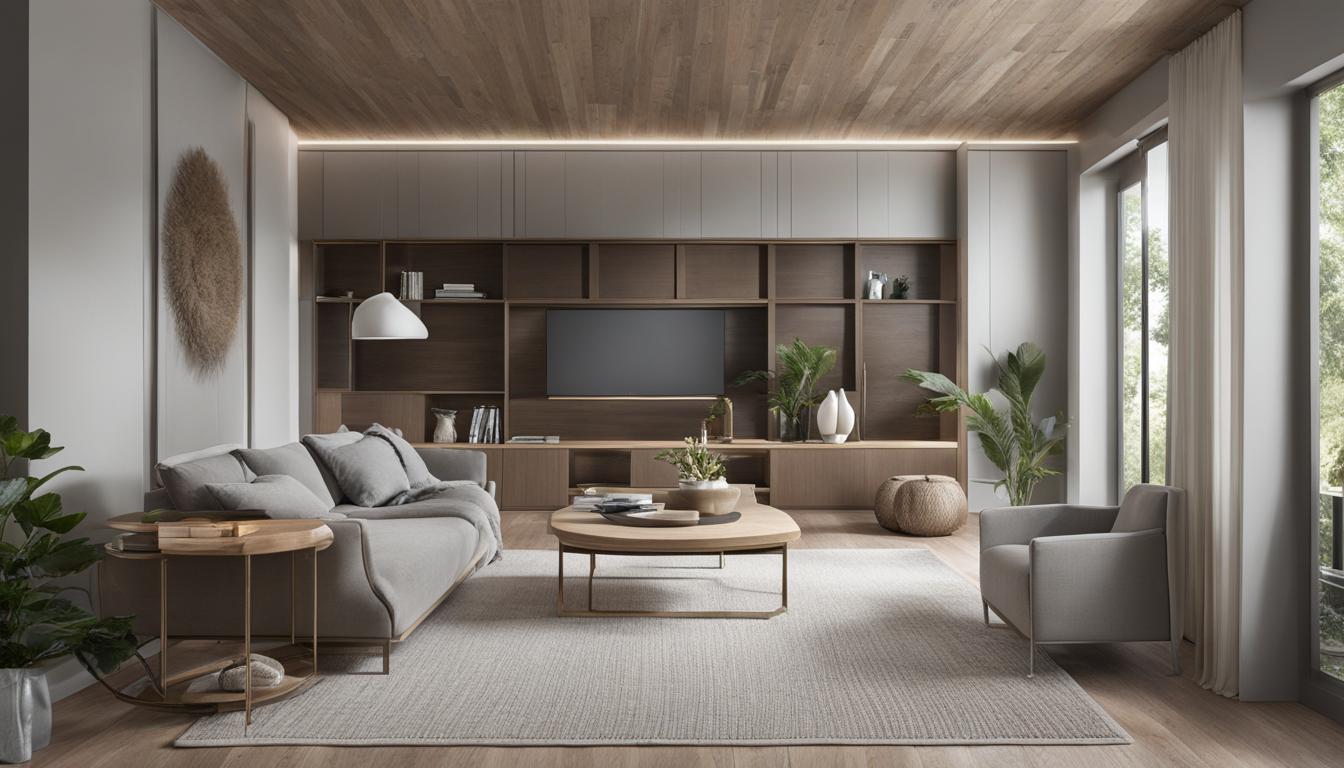Organising your home and life can have a significant impact on your overall well-being and productivity. By using mental imagery and visualisation techniques, you can effectively declutter and organise your living spaces. This article explores the concept of organising with visualisation and how it can transform your home and life.
Key Takeaways:
- Visualisation techniques can help you declutter and organise your home and life.
- Mental imagery allows you to develop a clear plan for organising your spaces.
- Creating a vision and engaging all your senses can enhance your organising experience.
- Consider the sensory aspects of your living environment when designing your space.
- Embrace visualisation to achieve an organised and harmonious living space.
The Importance of Being Organised
Our environment has a profound effect on our mental state and overall happiness. Disorganised and cluttered spaces can lead to higher levels of stress, anxiety, and depression, particularly among women. Being organised not only allows you to feel comfortable in your space but also enables you to find things easily when you need them. It’s important to recognize that everyone’s definition of being organised may vary, and there is no one-size-fits-all approach to home organisation.
When our surroundings are chaotic, it can be challenging to focus and be productive. Mental strategies for home organisation, such as visualisation techniques, can help create a sense of order and calmness. Visualising a clean and organised space can motivate and inspire you to take action in decluttering and arranging your home. By mentally envisioning an organised environment, you can develop a plan and set goals to achieve your desired outcome.
Life organisation visualisation techniques can extend beyond physical spaces. By visualising your schedule and prioritising tasks, you can better manage your time and achieve a greater sense of control and balance in your life. Visualising can also help you anticipate potential challenges and come up with strategies to overcome them. Through mental imagery, you can create a roadmap for success and enhance your productivity and overall well-being.
Incorporating mental strategies for home and life organisation can have a transformative effect on your well-being. By recognising the importance of being organised and harnessing the power of visualisation techniques, you can create harmonious living spaces that promote productivity, reduce stress, and enhance your overall quality of life.
Understanding Clutter
Clutter is an accumulation of items that no longer serve a purpose and take up valuable space in our homes. It can range from old clothes and unused appliances to paperwork and sentimental objects. The presence of clutter can create feelings of overwhelm, stress, and make it difficult to find and access the things we truly need.
Decluttering with mental imagery and creating order with visualization can help us tackle the challenge of clutter. By visualizing our space without the unnecessary items, we can identify what no longer serves us and let go of it. This process allows us to create a clear vision of an organized and clutter-free space that fosters serenity, productivity, and a sense of well-being.
Through the power of mental imagery, we can transform our cluttered spaces into functional and harmonious environments. By developing a clear mental picture of what an organized space looks like, we can begin to identify the steps needed to achieve it. Visualizing an organized space also enables us to make decisions about what to keep and what to let go of, ensuring that our belongings align with our current needs and aspirations.
Creating order with visualization is more than just tidying up our physical surroundings. It is a process that allows us to let go of the excess and embrace a simpler, more intentional way of living. By decluttering with mental imagery, we can create a space that reflects our values and supports our well-being.
The Power of Visualization in Organizing
When it comes to organizing your home and creating a harmonious living space, the power of visualization cannot be underestimated. Visualizing how you want your space to look and function allows you to develop a clear plan and make informed decisions about what to keep and what to let go. By mentally organizing your entire house before taking any physical action, you can save time, energy, and avoid common organizing pitfalls.
One of the key benefits of visualization in organizing is that it provides a decision-making shortcut. When faced with clutter or difficult choices about what to do with certain items, visualizing your ideal space can offer guidance and clarity. It allows you to imagine how each item fits into the bigger picture and whether it aligns with your vision of an organized and clutter-free environment.
Visualization also helps to maintain focus throughout the organizing process. By regularly revisiting your mental image of an organized space, you can stay motivated and on track. It acts as a reminder of the end goal and provides a sense of satisfaction as you see your vision come to life.
Envisioning Organized Spaces
Visualizing organized spaces goes beyond just decluttering and arranging items. It involves envisioning the atmosphere, functionality, and overall ambiance of each room. Consider how you want to feel in each space, whether it’s a sense of calm and tranquility in the bedroom or creativity and inspiration in your home office.
Creating a mental image of your problem space transformed into your ideal vision helps you gain clarity and motivation to make necessary changes. It allows you to identify the specific elements, such as colors, furniture, and layout, that will contribute to the overall organization and functionality of the space.
| Benefits of Visualization in Organizing | How It Helps |
|---|---|
| Decision-making shortcut | Guides choices about what to keep and what to let go |
| Maintaining focus | Keeps you motivated and on track |
| Creating a clear plan | Helps you develop a step-by-step approach to achieve desired results |
Visualizing organized spaces goes beyond just decluttering and arranging items. It involves envisioning the atmosphere, functionality, and overall ambiance of each room.
Take the time to visualize your problem space and develop a vision plan. Record your vision and the feelings associated with it, whether through writing or sketching. This plan will serve as your guide throughout the organizing process, helping you make decisions, stay focused, and maintain motivation.
By harnessing the power of visualization, you can transform your home into an organized and harmonious sanctuary. Embrace the opportunity to envision your ideal spaces and watch as the physical manifestation of your vision brings you a sense of peace, productivity, and joy.

| Benefits of Developing a Vision Plan | How to Develop a Vision Plan |
|---|---|
|
|
The Benefits of a Multisensory Approach
When it comes to organising your home and creating an environment that promotes productivity and well-being, visualisation is a powerful tool. But why stop at just visualising? By incorporating a multisensory approach, you can enhance your experience and achieve even greater results.
Engaging all your senses in the organising process can create a more harmonious living environment. Consider the power of touch – incorporating different textures and materials can add depth and character to your space. Soft fabrics can bring comfort, while smooth surfaces can promote a sense of cleanliness and order.
In addition to touch, smell can also play a significant role. By introducing soothing scents like lavender or invigorating fragrances like citrus, you can create a more pleasant and relaxing atmosphere. Smells can influence our mood and enhance our overall experience in a space.
“A multisensory approach to organising not only appeals to our sight but also engages our other senses, creating a more immersive and transformative experience.” – [Insert Expert Name]
Lastly, don’t forget about sound. Incorporating calming music or nature sounds can help create a peaceful and serene environment. By reducing external noise and filling your space with pleasant sounds, you can enhance focus and concentration.
By taking a multisensory approach to organising, you can create a space that not only looks great but also feels great. So go ahead, use your senses to envision an organised and harmonious living space that truly speaks to who you are.
Table: The Benefits of a Multisensory Approach
| Sense | Benefit |
|---|---|
| Touch | Enhances the tactile experience and adds depth to the space |
| Smell | Creates a more pleasant and relaxing atmosphere |
| Sound | Promotes focus and concentration |
The Importance of Designing with Sensory Considerations
When it comes to organising your home and life, it’s not just about decluttering and arranging your belongings. The design of your living spaces plays a crucial role in creating an environment that promotes efficiency, productivity, and a sense of calm. By considering sensory aspects such as lighting, acoustics, and spatial layout, you can transform your space into a harmonious and functional oasis.
“The way we design our living spaces influences our mindset and ability to stay organised,” says interior designer Emma Stevens.
“By incorporating sensory considerations into the design process, we can create an environment that supports mental organisation and enhances overall well-being. From the selection of materials to the arrangement of furniture, every element contributes to the overall experience.”
When it comes to lighting, natural light is key to creating a calming atmosphere. Consider the orientation of your windows and use light-filtering curtains or blinds to control the amount of natural light entering your space. In addition, incorporate layered lighting with different fixtures and bulbs to create a variety of moods and functionality throughout the day.
Sound insulation is another important consideration for creating a focused and organised space. Use materials that absorb sound, such as carpets, curtains, and acoustic panels, to reduce external noise and create a quieter environment. This can significantly improve concentration levels and help maintain a clear and organised mindset.
Lastly, the spatial layout of your home can greatly impact your ability to stay organised. Ensure that furniture is arranged in a way that maximises flow and minimises obstacles. Consider the functionality of each room and strategically place storage solutions to make it easy to access and put away items. A well-designed spatial layout promotes efficiency and reduces visual clutter, allowing for a more organised and peaceful living environment.
Table 1: Creating an Organised and Sensory-Friendly Living Space
| Aspect | Sensory Considerations |
|---|---|
| Lighting | Maximise natural light, incorporate layered lighting with different fixtures and bulbs |
| Sound | Use materials that absorb sound, such as carpets, curtains, and acoustic panels |
| Spatial Layout | Arrange furniture for optimal flow, strategically place storage solutions |
Table 1: Considerations for creating an organised and sensory-friendly living space.
Designing with sensory considerations is an essential aspect of organising your home and life. By creating an environment that supports mental organisation, you can enhance your overall well-being and create a space that brings you joy and productivity. So, when decluttering and arranging your belongings, don’t forget to think about the sensory aspects that make a difference in how you experience and interact with your space.
Conclusion
Organising your home and life with mental strategies and visualisation techniques can have a transformative impact on your overall well-being and productivity. By harnessing the power of visualisation, you can effectively declutter and create an organised living space that promotes a sense of harmony and tranquillity.
Creating a clear vision of how you want your space to look and function is essential. By mentally organising your entire house before taking any physical action, you can develop a plan and make informed decisions about what to keep and what to let go. Visualisation provides a decision-making shortcut, keeps you focused, and boosts motivation throughout the organising process.
Beyond visualisation, consider adopting a multisensory approach to enhance your organising experience. Engaging all your senses, from touch to smell and sound, can create a more enjoyable and transformative environment. Incorporate soothing scents, pleasant textures, and calming music into your space to enhance the overall atmosphere and make organising a truly immersive experience.
By embracing the power of visualisation and incorporating mental strategies for home organisation, you can create an organised and harmonious living space that supports your overall well-being. Take the time to develop a vision plan, engage all your senses, and create a space that brings you joy and tranquillity. Let visualisation be your guide on the path to a more organised and fulfilling life.
FAQ
Why is being organised important?
Being organised can reduce stress, anxiety, and depression, and make it easier to find things when you need them.
What is clutter?
Clutter is anything that we don’t need, want, or use and that takes up our time, energy, and space.
How can visualisation help with organising?
Visualisation helps you develop a clear plan, make decisions about what to keep and let go, and stay focused and motivated.
How can I visualise my problem space?
Close your eyes and imagine how you want the space to look and function, considering colors, furniture, and ambiance.
Why should I record my vision?
Recording your vision serves as a guide throughout the organising process, helping you stay focused and motivated.
How can a multisensory approach enhance organising?
Engaging all your senses, such as touch, smell, and sound, can create a more enjoyable and transformative experience.
What sensory aspects should I consider in my living spaces?
Factors such as lighting, acoustics, and spatial layout can create a more conducive environment for organisation and productivity.
How can visualisation transform my overall well-being?
By visualising and organising your living spaces, you can create a more harmonious and peaceful environment for yourself.





5 responses to “The Visualisation of Space: Organising Your Home and Life with Mental Imagery”
[…] Let go of past hurts and fears to create space for love to enter your life. […]
[…] made and celebrate small wins. By releasing limiting beliefs and negative thoughts, you create space for abundance and opportunities to flow into your life, ultimately attracting your dream […]
[…] Holding onto resentment and anger only keeps you stuck in a negative cycle. To break free, practice forgiveness and let go of any negative emotions that are weighing you down. When you release these negative energies, you create space for positive manifestations to enter your life. […]
[…] be willing to explore different avenues. By releasing attachment to specific outcomes, you create space for the universe to bring love into your life in its own perfect […]
[…] your mind cannot distinguish between what is real and what is imagined. By harnessing the power of mental imagery, you are sending a clear message to the universe that you are already living your desired reality. […]